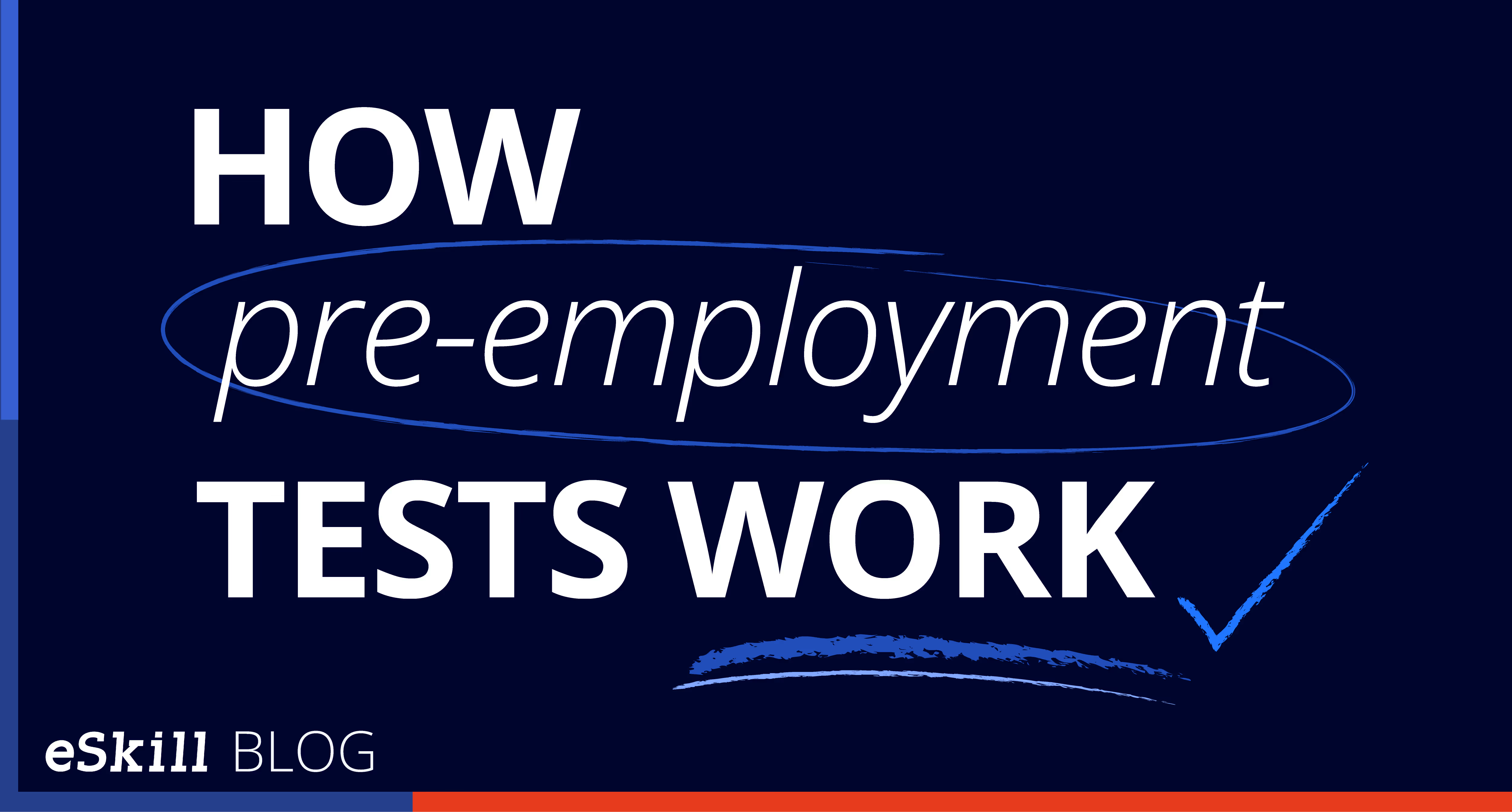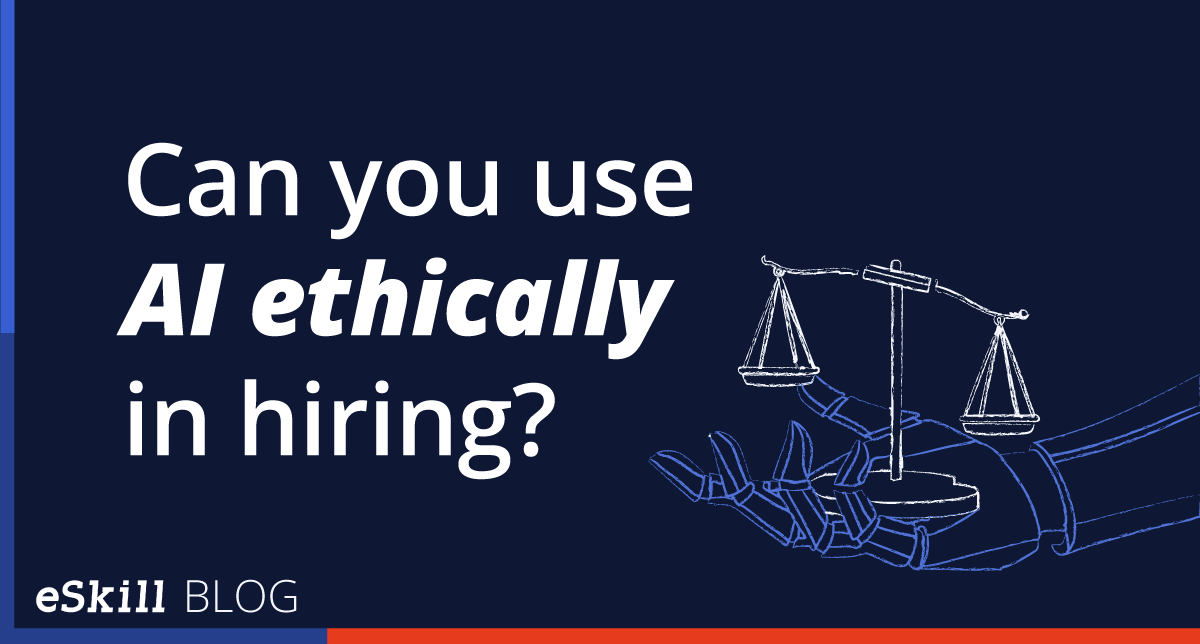Hiring is more than gut instinct and a glance at a resume.
And yet with all the effort recruiters put into reviewing cover letters, multiple rounds of interviews, and careful selection, finding the right candidate for the job can still seem like a toss-up. Recruiters need signs — hard data — that can point to the right candidate.
That’s why pre-employment tests are becoming an essential tool for employers who want to hire smarter.
Whether you're hiring medical billers, mechanical engineers, or remote customer service agents, a good test can help you cut through resume noise and zero in on candidates with the right skills for the job.
This is especially important with record numbers of AI-generated resumes and cover letters flooding employers’ ATS screeners these days — not to mention growing candidate fatigue in a tight job market. No one wants to send hundreds of resumes into the void without ever hearing back. And let’s not forget the HR industry’s broad, if scattered, move toward skills-based hiring. When you incorporate pre-employment testing, applicants have a chance to prove their skills, even if they don’t have the “right” background.
As noted in the Talent Board’s 2016 Candidate Experience Research (cited by the Society for Human Resource Management), 82% of companies were using some form of pre-employment assessment in their hiring process. These assessments help employers increase hiring accuracy, improve retention rates, and support diversity and inclusion initiatives. You don’t have to take it from us, either. According to a 2022 meta-analysis by prominent I/O psychologist Paul R. Sackett and his colleagues, job-knowledge tests are one of the top predictors of job success, alongside structured interviews.
In this in-depth guide, we’ll walk you through what pre-employment tests are, how they work, and how you can use them to make more informed, confident hiring decisions.
What is a pre-employment test?
A pre-employment test is an assessment used during the hiring process to evaluate a candidate’s job-based knowledge, skills, personality fit, or cognitive abilities. These tests can help predict how well a candidate will perform in a given role, offering a data-driven way to compare applicants.
Unlike resumes (which can be exaggerated), or interviews (which are susceptible to bias), tests offer data-backed insights to support hiring decisions.
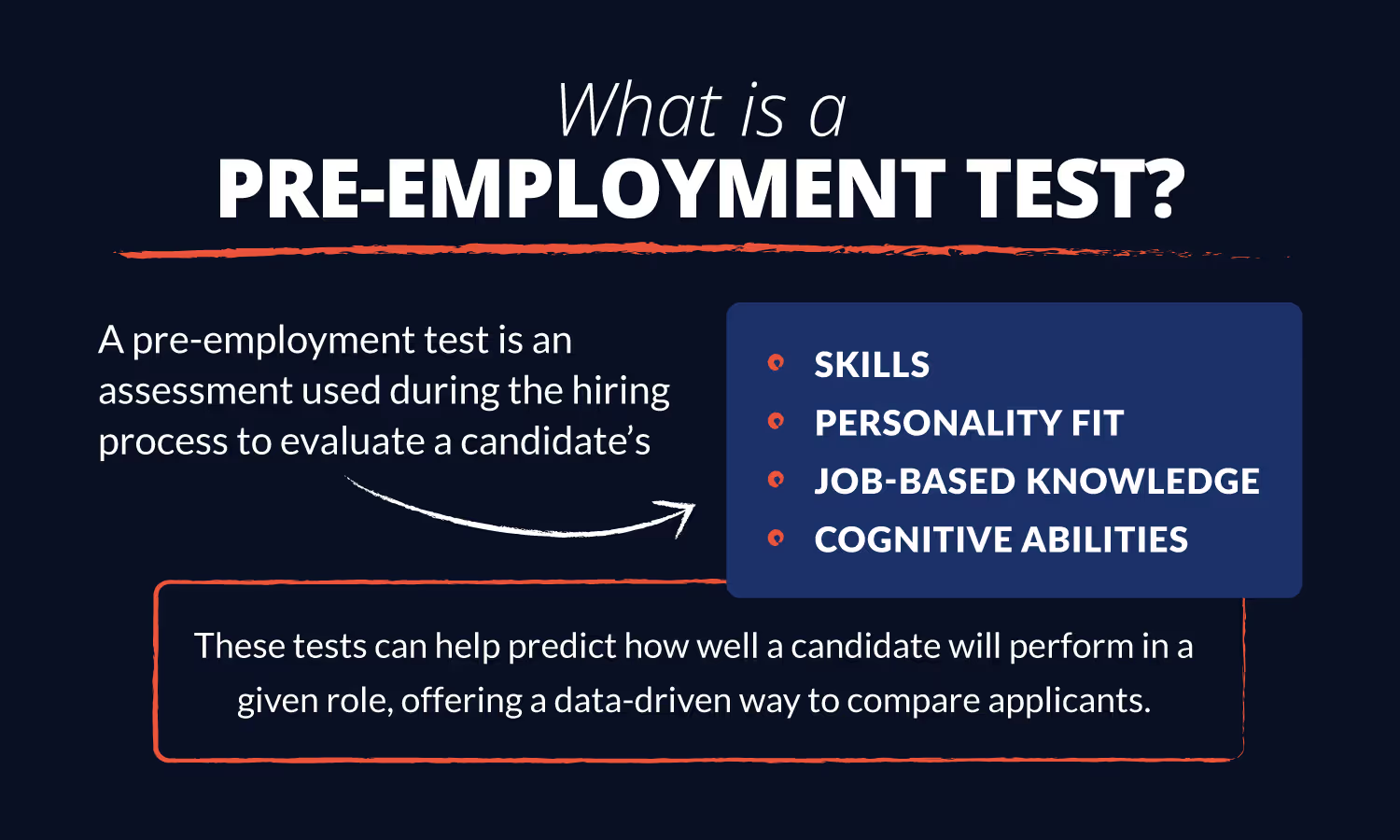
Research shows these tests can significantly improve hiring accuracy. A 2022 meta-analysis published in the Journal of Applied Psychology by Paul R. Sackett and his colleagues (which we love; thanks for your hard work, Paul!) found that structured interviews, job knowledge tests, and cognitive ability assessments are among the most effective predictors of job performance, outperforming common metrics like years of experience or education level.
And pre-employment platforms (like eSkill!) allow employers to administer and customize these assessments to match specific job requirements, streamlining hiring for high-volume and specialized roles.
Types of pre-employment tests
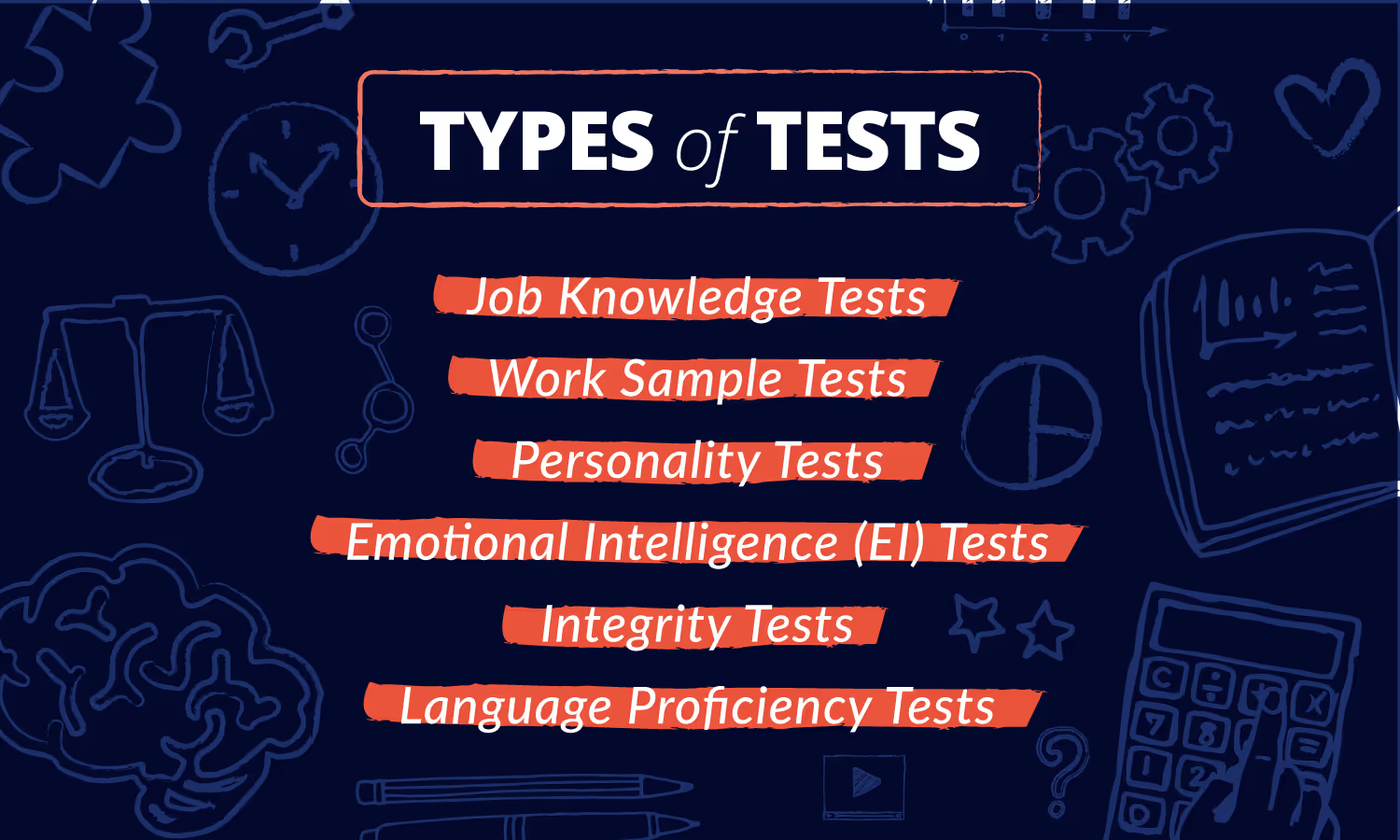
Pre-employment assessments can be tailored to specific job requirements, or they can assess general aptitudes like cognitive ability and integrity.
In general, hard skills tests outperform generalized cognitive ability and personality tests in terms of predicting job performance, according to Sackett’s meta-analysis (thanks again, Paul!).
Ultimately, however, the types of tests you will use will depend on your industry, the roles you’re hiring for, and your needs in the role.
Here’s a breakdown of the most-used types of pre-employment tests by efficacy, definition, use cases, and pros and cons.
Job Knowledge Tests
A type of hard skills assessment, job knowledge tests measure specific, role-related abilities and technical competencies. They’re ideal for evaluating whether candidates have the knowledge to perform day-one job functions.
According to Sackett’s study, job knowledge tests are the second most predictive hiring tools — right behind structured interviews.
Unlike a work sample test, which we’ll get to later, job knowledge tests assess knowledge of definitions, role-specific facts and concepts, and procedures, typically in a multiple-choice or free response format.
Here are some examples:
- A warehouse supervisor might be tested on inventory management systems, OSHA regulations, or forklift safety protocols.
- A customer service representative might answer questions about conflict resolution, CRM software navigation, or response time metrics.
- A data analyst might be tested on Excel formulas, SQL queries, or data visualization best practices.
- An entry-level accountant might complete questions on GAAP standards, reconciliation processes, or use of accounting software like QuickBooks or Xero.
- A 911 dispatcher might answer scenario-based questions on emergency prioritization, clear radio communication, or stress management.
Job knowledge tests perform well because they have high content validity: they measure what matters for the job at hand. Which is also a reason why work sample tests, also called job simulation tests, work so well.
Work Sample Tests
Work sample tests, also known as job simulation assessments, replicate real job tasks to provide a hands-on preview of candidate performance. They’re immersive, engaging, and highly predictive of job fit.
Candidates perform tasks they would do on the job, for example:
For a plumber: A simulated plumbing repair scenario (real or virtual) where the candidate must identify a leak or blockage and describe or demonstrate the proper fix using standard parts.
For a medical coder: An on-screen coding challenge where the candidate reads clinical documentation and selects the appropriate ICD-10, CPT, or HCPCS codes for diagnoses and procedures.
For a city planner: A task where the candidate reviews a mock zoning application and writes a short report evaluating compliance with land-use regulations, environmental impact, and community fit.
Like job knowledge tests, these tests perform well because they directly assess job-specific behavior, and additionally contextualize the work for potential hires.
And if candidates find they don’t know how to do the work at hand, they might choose to self-select out of the application process — saving both the organization and the applicant time.
Cognitive Ability Tests
Cognitive ability tests assess general mental aptitude. In other terms, they test how well a candidate can learn, process information, and solve problems.
Cognitive ability tests work well for entry-level roles where candidates don’t necessarily need to come in knowing any information for the job. We can expand the definition of “cognitive ability” to include basic literacy and numeracy tests — and this can be especially useful when you’re hiring for roles that don’t necessarily require a high school diploma but where candidates must know how to read and write, such as for high-volume factory floor roles.
Here are some examples:
- Numerical Reasoning Tests: For example, candidates are shown a chart or table and asked to calculate percentages, analyze trends, or solve word problems involving ratios or basic math.
- Verbal Reasoning Tests: Candidates may be asked to read a short passage and answer questions about its meaning, or identify grammatical or logical errors.
- Abstract or Logical Reasoning Tests: Like pattern recognition puzzles where candidates must identify the next shape or sequence in a logical progression.
- Memory or Attention Tests: For example, tests that flash numbers, symbols, or images for a few seconds and ask the candidate to recall or match them under time pressure.
- Spatial Reasoning Tests: Candidates mentally rotate 2D or 3D objects to determine how they would look from a different angle.
For entry-level roles, aptitude tests like these can determine whether a candidate is ready to learn the duties for the role at hand, whether it’s a customer service role or something as intense as air traffic control. And let’s be honest, anyone who’s worked in customer service and dealt with the personalities of many kinds of people knows it’s intense, too. Speaking of which…
Personality Tests
Personality tests evaluate behavioral tendencies and interpersonal style, helping employers assess team compatibility, leadership potential, and cultural fit. Personality assessments are more predictive when they’re work-contextualized — that is, when questions relate to behavior on the job.
For example, if you ask a candidate how organized they are, they may give you a general answer. Maybe they leave the dishes in the sink for three days; maybe they don’t sort their laundry. But if you ask how organized they are at work, the answer might change completely — they maintain project deadlines, have excellent software hygiene, and answer their emails promptly. The extra contextualization gives hiring managers a lot more to work with.
A popular personality test for business is the Big Five, which covers Openness, Conscientiousness, Extraversion, Agreeableness, and Neuroticism.
While the OCEAN model is one of the most validated and scientifically grounded personality frameworks, its predictive value for job performance is mixed unless paired with job-specific context or other assessments like cognitive or skills-based tests.
Sackett and previous studies have all found that conscientiousness is the only major personality trait that consistently predicts success on the job, outperforming the four other traits of the Big Five.
Of course, the efficacy of personality tests is also highly variable depending on the job you’re hiring for.
For sales roles, for example, high extraversion and low neuroticism may matter more. In a people-facing role like this one, salespeople often need resilience, sociability, and persistence.
Situational Judgment Tests (SJTs)
SJTs present realistic, job-related scenarios and ask candidates to choose how they would respond. They are considered low‑fidelity simulations, meaning they depict real work problems without requiring actual performance in those settings.
These help assess decision-making, ethics, and emotional intelligence. According to the U.S. Office of Personnel Management, SJTs are especially useful in interpersonal, customer-facing, or supervisory roles.
A key strength of SJTs is their lower adverse impact compared to traditional cognitive ability tests. Meta-analyses and peer-reviewed studies show SJTs tend to yield smaller subgroup differences (across ethnicity, gender, socioeconomic status), reducing bias and supporting more equitable hiring outcomes. This makes them an appealing tool for organizations with diversity and inclusion goals.
Research has found that SJTs produce significantly fewer adverse subgroup differences than cognitive tests. Another review indicated that video-based SJTs can further shrink ethnic performance gaps compared to text formats.
Because the questions are realistic and job-related, candidates often perceive SJTs as more fair and engaging than abstract tests, too.
Emotional Intelligence (EI) Tests
EI assessments measure how well a person perceives, understands, and regulates emotions — both their own and others’. These assessments go beyond traditional personality tests by measuring specific emotional and social abilities that influence behavior in interpersonal and high-pressure situations.
In people-facing roles like management, sales, healthcare, and customer service, candidates with higher EI are often better at handling pressure, empathizing with others, and maintaining productive relationships — all of which improve team performance and customer satisfaction.
While not as strong a predictor of job performance as cognitive ability or job knowledge tests, EI assessments are valuable for roles that rely on interpersonal dynamics.
That said, the validity depends on the test format: Ability-based tests (like the MSCEIT) tend to be more predictive than self-report tests, which can be biased by social desirability.
Integrity Tests
Integrity tests evaluate a candidate’s honesty, reliability, moral judgment, and attitudes toward rule-following — all critical traits in roles that demand trust, ethical conduct, and adherence to policy. These assessments aim to predict the likelihood of a person engaging in counterproductive work behaviors (CWBs) such as theft, fraud, absenteeism, time-wasting, or policy violations.
Despite being lesser-known than interviews or skills tests, integrity assessments ranked surprisingly high in Sackett’s meta-analysis, outperforming years of experience, interests, and general personality inventories. They also show low adverse impact, making them a relatively fair and defensible selection method across diverse groups.
There are two types: overt integrity tests (direct questions about ethics) and personality-based integrity tests (measuring traits linked to counterproductive work behavior).
These tests are used frequently in retail, finance, healthcare, and government and law enforcement — roles where ethical lapses could cause financial loss, legal risk, or damage to reputation.
Language Proficiency Tests
Language proficiency tests measure a candidate’s ability to read, write, speak, and understand a particular language—most often English in U.S.-based hiring contexts. These assessments evaluate both basic communication and more advanced language skills like grammar, vocabulary, and comprehension, depending on the job requirements.
These tests can be general (e.g., assessing conversational fluency) or tailored to specific workplace tasks—like writing an email, reading a technical document, or handling a live customer inquiry.
Language proficiency is essential for:
- Customer service and support roles, where clear communication directly impacts customer satisfaction.
- Global or multilingual teams, where collaboration across language barriers is key.
- Public-facing positions in healthcare, transportation, government, or retail.
- Documentation-heavy roles like technical writing, compliance, or administration.
In fact, federal regulations have long recognized the importance of language proficiency. For example, U.S. commercial truck drivers must pass an English language assessment to operate legally, ensuring they can read road signs, communicate with law enforcement, and complete safety documentation (per FMCSA regulations).
What can I expect from a pre-employment test?
On the employer and candidate side, the experience of designing and implementing versus taking the test definitely look different, but they work in tandem.
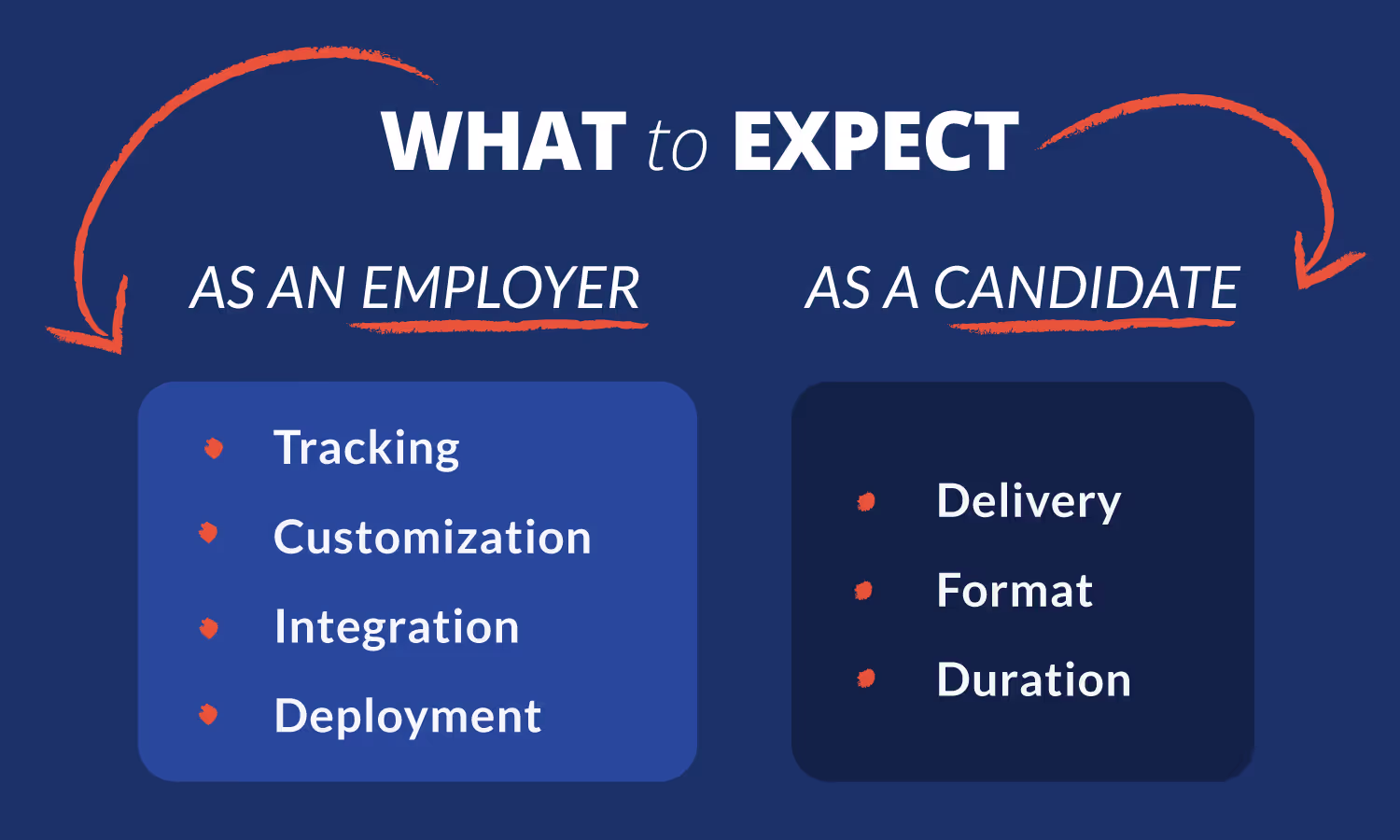
If you’re an employer, you can expect:
Tracking
Dashboards allow recruiters to monitor completion and analyze results.
Customization
Most platforms allow for fully customizable assessments aligned to real job tasks.
Integration
Easily integrated into ATS platforms like iCIMS, Greenhouse, and Paylocity.
Deployment
A pre-employment test may be administered online or in person. Tests can range from 10-minute typing assessments to multi-hour technical simulations. Some are timed; others are not. The format may include multiple-choice questions, drag-and-drop interactions, short written answers, or practical assignments.
On the other side, candidates can expect:
Delivery
Tests are usually delivered via the employer’s ATS or directly from an assessment platform straight to a candidate’s email inbox.
Format
May include multiple-choice, essay, video responses, audio questions, simulations, and drag-and-drop.
Duration
Ranges from 10 minutes to over an hour, depending on test complexity. However, we recommend keeping the tests under 30 minutes.
The growth of pre-employment testing
The growth of pre-employment testing comes down to a number of factors. A switch to remote hiring, AI-generated resumes and cover letters, a high influx of applications, a transition to skills-based rather than education-based hiring, talent shortages, and growing research all point to the validity of skills tests in the hiring process.
Let’s look at each factor individually.
Remote hiring
As remote work became widespread post-2020, traditional in-person interviews and on-site evaluations gave way to digital-first hiring processes. Pre-employment assessments provided a standardized, scalable, and location-agnostic way to evaluate candidates — making them indispensable for companies hiring outside their immediate geography.
In virtual settings, tests serve as objective filters early in the hiring funnel, especially for roles where in-person impressions are no longer viable. This also supports asynchronous hiring, where candidates can complete evaluations on their own time.
Data-driven HR
Modern talent teams are increasingly focused on evidence-based hiring, using tools like applicant tracking systems (ATS), talent intelligence platforms, and workforce analytics. Pre-employment assessments provide structured data that feeds directly into these systems—allowing for better predictive hiring models and ongoing performance tracking.
According to SHRM, organizations that use data to guide hiring decisions are more likely to see improvements in retention, productivity, and cultural fit.
DEI and bias reduction
One of the most promising aspects of pre-employment testing is its ability to help reduce unconscious bias in the hiring process. While resumes can reflect socioeconomic privilege (e.g., elite schools, polished formatting, high-profile internships), skills tests and structured assessments evaluate what truly matters: the ability to do the job.
A McKinsey study showed that companies with diverse workforces outperform peers by 36% in profitability. Testing can support diverse pipelines by focusing on potential over pedigree.
Talent shortages
Sectors like healthcare, manufacturing, education, and customer service are facing serious labor shortages — and competition for skilled candidates is fierce. Pre-employment tests help teams move faster, identify hidden talent, and confidently hire from nontraditional backgrounds.
By verifying skills upfront, employers can reduce the risk of bad hires and ensure that candidates can hit the ground running — even if they lack a formal degree or prior experience in the exact role.
Filtering AI-generated applications
The rise of AI-generated resumes and cover letters has made it more difficult for recruiters to spot genuine qualifications. With tools like ChatGPT creating polished application materials, testing is one of the few ways to cut through surface-level polish and verify a candidate’s real capabilities.
Work sample tests, cognitive assessments, and scenario-based evaluations give employers a clearer signal of who can actually perform the job — not just present well on paper.
High applicant volume
For high-volume hiring environments — such as retail, call centers, logistics, and seasonal staffing — employers often receive hundreds or thousands of applications per job posting. Resume reviews are time-consuming and prone to bias. Pre-employment tests offer a fast, fair, and scalable way to screen candidates based on merit.
Tools like automated scoring and assessment dashboards enable HR teams to focus their time on top performers, saving time and reducing cost-per-hire.
Why Use Pre-Employment Tests?
Hiring today isn’t just about filling open roles — it’s about finding the right people, faster and more fairly. That’s where pre-employment tests come in. Backed by decades of industrial-organizational psychology research, these assessments help employers make evidence-based decisions that improve hiring outcomes across the board.

Here’s what you stand to gain:
Reduced time-to-hire
Manual screening takes time—and time costs money. Pre-employment tests automate early filtering, prioritize top candidates, and free up hiring managers to focus on final-stage interviews.
One of our clients, Orvis, reduced their time-to-hire by 50%.
Better quality of hire
The candidates who score well on validated tests are more likely to succeed in the role. Whether you're assessing job knowledge, problem-solving, or software proficiency, these tests offer a reliable preview of real-world performance.
One of our candidates, Navex Global, was able to eliminate 60% of their hiring pool, the unqualified candidates, using a skills assessment.
Lower turnover
Bad hires leave faster — and cost more. When candidates are accurately matched to the demands of a role, they’re more likely to stay and thrive. Testing helps reduce early-stage attrition by improving fit.
Beach Front Property Management’s partnership with eSkill led to a 91% retention rate in new hires.
Fairer hiring
Unlike gut instincts or résumé filters, pre-employment assessments offer objective, consistent criteria for evaluating talent. This levels the playing field for candidates from nontraditional backgrounds, helping teams advance diversity and equity goals.
Scalability
Need to screen 500 applicants for a remote customer support team? Or standardize testing across multiple locations? Pre-hire assessments scale effortlessly — no matter your team size or hiring velocity.
Our client GE Vernova was able to improve their high-volume hiring with our platform.
Steps of taking a pre-employment test: the candidate journey
Understanding the candidate's experience during a pre-employment test is essential. A poor testing experience can lead to candidate drop-off, negative impressions of your brand, and lost top talent. On the other hand, a clear, user-friendly, and respectful process can boost completion rates, candidate satisfaction, and employer reputation.
Here’s a step-by-step look at what a typical assessment journey looks like from the candidate’s side — and how to optimize each stage for better hiring outcomes.
1. Invitation to Test
The candidate receives an email or message through your applicant tracking system (ATS) or skill assessment platform with a link to begin the test. The best invitations include:
- A warm, human tone
- Clear explanation of the purpose (e.g., “This helps us understand your skills more objectively”)
- Estimated time to complete
- Deadline or time window
According to research by Talent Board’s Candidate Experience survey, 61% of candidates said they would be more likely to complete assessments if they understood how the results would be used.
2. Instructions and Overview
Before the test begins, candidates are typically presented with a brief rundown of:
- The test format (e.g., multiple choice, video, simulation)
- Number of questions or sections
- Time limits (if applicable)
- Rules or expectations (e.g., no outside help, webcam monitoring if proctored)
Candidates appreciate transparency. Studies show that clear expectations reduce test anxiety and improve performance, especially for underrepresented groups.
3. Practice or Demo Questions (Optional)
Some platforms offer practice questions, tutorials, or walkthroughs. This is especially valuable for reducing candidate anxiety, improving accessibility for neurodivergent individuals or those unfamiliar with digital assessments, and clarifying confusing test formats (like drag-and-drop simulations or live coding).
4. Taking the Test
The assessment typically begins once the candidate clicks “start.” Most tests are:
- Timed or guided by soft time recommendations
- Completed in one sitting
- Designed to be mobile-friendly (important for accessibility and DEI)
- Optional: add proctoring and anti-cheat tools to promote test fairness and ensure accurate results
Depending on the type of assessment, this could include cognitive ability tests, job simulations, personality questionnaires, or hard skills modules (like Excel or typing).
TIP: With 62% of job seekers using mobile devices to apply for jobs, mobile optimization is crucial for test completion and candidate equity.
5. Submission and Scoring
After completing the test, results are automatically submitted for scoring. Most platforms use:
- Instant grading for multiple-choice or technical questions
- AI-assisted or manual review for video and open-ended responses
At this point, candidates are typically returned to your ATS or receive a “thank you” message confirming completion.
6. Sharing Results or Feedback (Optional)
Some companies choose to close the loop with candidates — especially if assessments are used early in the funnel. This might include:
- Sharing scores or proficiency levels
- Offering feedback or personalized insights
- Using results to tailor interview questions
TIP: According to a LinkedIn Talent Solutions survey, 94% of candidates want feedback after interviews, and even basic performance insights can help candidates feel respected — even if they aren’t selected.
Why the candidate experience matters
Every step of the candidate journey impacts your employer brand. A test that feels confusing, impersonal, or overly burdensome can turn great candidates away.
On the flip side, a seamless and respectful experience builds trust, improves engagement, and signals that your company values fairness and clarity.
Steps of using pre-employment tests: the employer’s perspective
Integrating pre-employment testing into your hiring process doesn’t have to be complicated, but it does require intentional planning. From selecting the right test to interpreting the results, here’s how the process typically works from the employer’s side:
1. Define the Role and Key Competencies
Before choosing any assessment, clarify what success looks like in the role. Are you hiring for customer service, data analysis, or mechanical aptitude? Pinpoint the hard and soft skills that matter most — this ensures the test actually reflects the job.
Example: For a customer support role, you might test for typing speed, emotional intelligence, and situational judgment.
2. Select or Customize the Test
Once the role’s competencies are defined, select an off-the-shelf test or create a customized one. Many platforms allow you to build your own by combining modules, like Excel + communication + logic.
TIP: Tools like eSkill allow full customization, so you can assess exactly what you need (and nothing you don’t).
3. Integrate the Test Into Your Hiring Workflow
Decide when in the process to send the assessment. Many employers include the test after an initial resume screen but before interviews. This helps narrow the pool without wasting time on unqualified candidates.
TIP: For high-volume roles, some teams automatically send assessments to all applicants and review only those who meet a certain threshold.
4. Invite Candidates and Monitor Completion
Send the test with clear instructions and a deadline. Some platforms allow automated follow-ups and real-time progress tracking, so you know who’s completed the test (and when). Consider including proctoring and anti-cheat tools to promote test fairness and accuracy.
5. Review the Results and Compare Candidates
Once results come in, review them alongside resumes and other application materials. Most platforms present results in dashboards showing overall scores, sub-skill breakdowns, and comparison benchmarks.
TIP: Look for patterns in performance, not just top scorers. A mid-range performer with strong communication skills might be a better long-term fit than someone with raw technical ability alone.
6. Use Results to Inform (Not Replace) Hiring Decisions
Assessments should complement — not replace — your broader evaluation process. Combine test results with structured interviews, references, and trial projects when relevant.
What the Results of Pre-Employment Tests Mean
Test results are typically presented as a score, percentile rank, or category (e.g., beginner, intermediate, advanced). Depending on the platform, you may also get insights into sub-skills (e.g., Excel formulas vs. pivot tables) or comparison benchmarks (e.g., industry averages).
Keep in mind:
- High scores indicate strength in a specific area but don’t guarantee success.
- Low scores don’t always mean rejection — especially if the skill can be trained.
- Use score thresholds cautiously and transparently.
- The best approach is to view test results as one part of a larger hiring picture.
TIP: A high score doesn’t always guarantee success, and a low score doesn’t mean rejection. Use test data as one piece of a broader evaluation strategy.
When should I use pre-employment tests?
Pre-hire tests can be a game changer in hiring — when used the right way. But like any tool, their effectiveness depends on how, when, and why you use them. You wouldn’t use a spoon to eat spaghetti. It’s not that spoons are useless — they’re just not made for that kind of job.
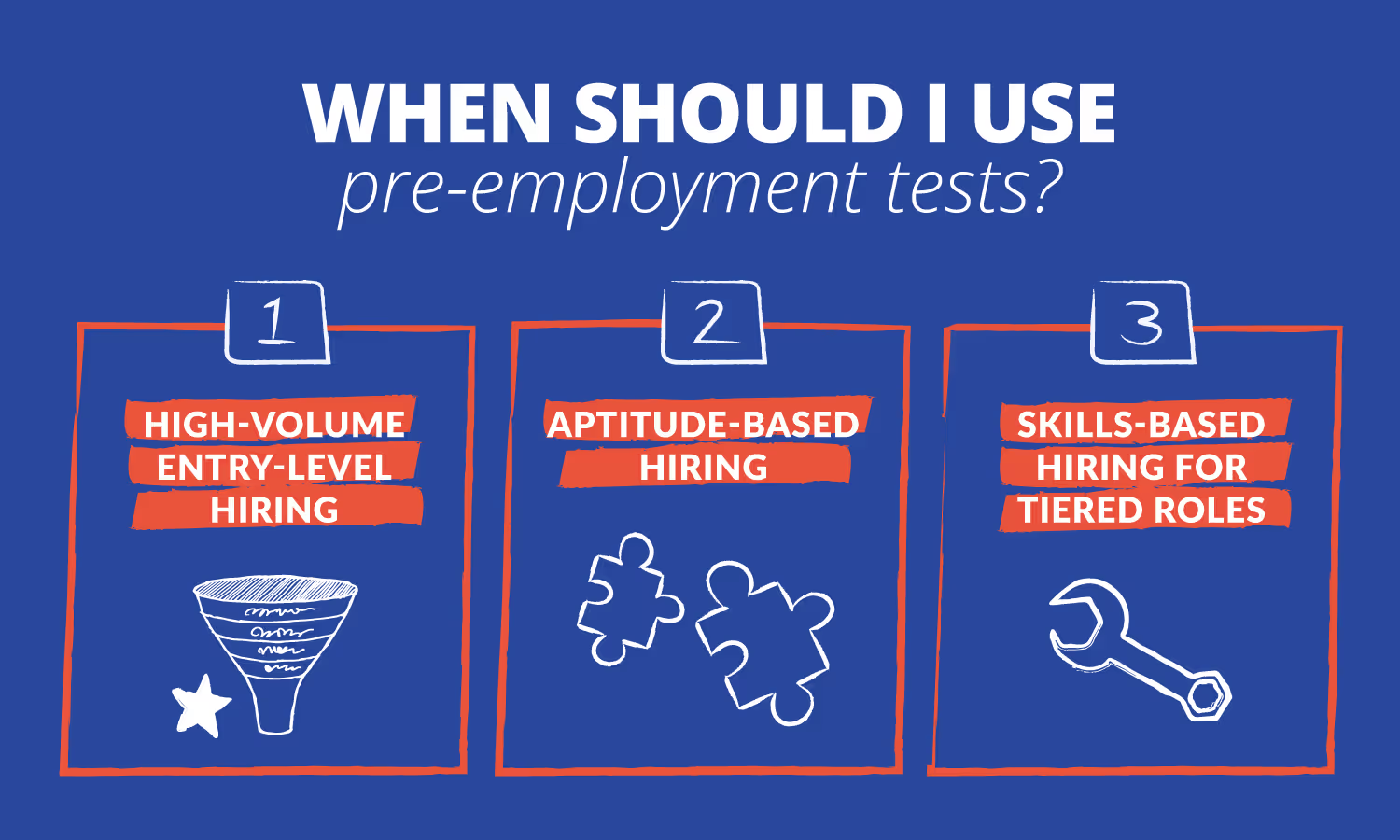
In the same way, pre-employment assessments shine in certain hiring contexts and are less effective in others.
High-Volume, Entry-Level Hiring
When you’re screening hundreds or thousands of applicants for roles like customer service reps, warehouse associates, medical billers or retail clerks, pre-hire tests help filter unqualified candidates quickly and fairly. Structured testing reduces recruiter fatigue and improves consistency across candidates.
A study by the Aberdeen Group found that companies using pre-hire assessments in high-volume hiring saw a 39% lower turnover rate.
Aptitude-Based Hiring
When hiring for potential over pedigree — say, for apprenticeships, internships, or training-heavy roles — cognitive ability tests and problem-solving assessments are often the best predictors of success. This approach also helps improve DEI by focusing on merit rather than traditional credentials like college degrees.
Skills-Based Hiring for Tiered Roles
For jobs with tiered pay structures — such as technicians, software developers, or administrative support — testing helps match candidates to the right level based on proficiency. This allows for more nuanced offers and a better fit from day one.
Our own client, GE Vernova, has benefited from using tests for hiring for high-volume, tier-based roles.
When shouldn’t I use pre-employment tests?
While pre-employment tests can be powerful tools for streamlining hiring and improving candidate fit, they’re not always the right choice. In certain situations, relying on skills tests or cognitive assessments may slow down your process, introduce legal risk, or fail to capture the qualities that actually matter for the role. Here are a few scenarios where you may want to rethink — or skip — pre-employment testing altogether:
When Hiring for Creative or Portfolio-Based Roles
For highly creative or subjective roles — such as writers, designers, videographers, or artists — traditional skills tests often fall short. These roles require a strong sense of style, voice, and originality, which can’t be accurately measured by standardized testing alone. Instead, a portfolio of past work is usually the best predictor of future performance.
In these cases, it’s more effective to conduct structured interviews with scenario-based questions and supplement them with a working session or a paid trial project when feasible.
When Hiring Senior-Level or Executive Positions
Pre-employment testing is generally designed to evaluate tactical or mid-level competencies — things like technical skills, attention to detail, or logical reasoning. But leadership roles require a far broader and more nuanced skillset: strategic thinking, emotional intelligence, decision-making under ambiguity, and team influence.
When the Test Isn’t Validated or Job-Relevant, and you’re not Prepared to Use the Results Objectively
If the test isn’t clearly tied to the job’s core duties — or if your team isn’t prepared to interpret the results meaningfully — it may introduce legal risks or unconscious bias. The EEOC requires that any selection test be job-related and consistent with business necessity, and failing to meet this standard can result in claims of discrimination.
Pre-employment testing only improves hiring outcomes if the results are interpreted correctly and used consistently. If your team lacks training in how to read test scores — or worse, if tests are used inconsistently across candidates — it can open the door to legal liability and hiring bias.
The Equal Employment Opportunity Commission (EEOC) warns that employers using selection procedures (like pre-hire assessments) must ensure those tests are job-relevant and non-discriminatory. Failing to validate your testing process can result in compliance issues, especially for government contractors or public sector agencies.
When the Role Demands Nuanced, Human-Centered Judgments
If you’re hiring someone whose job is to lead teams, manage ambiguity, or drive innovation (such as an executive, strategist, or creative director), the nuance of their thinking and interpersonal skillset often can’t be reduced to a multiple-choice format.
As HBR notes, executive hiring decisions often hinge more on soft skill evaluations, 360-degree references, and simulations than on automated testing.
When Your Candidate Will Resent You for It
If your test feels redundant, impersonal, or excessive — especially for senior-level, highly skilled, or in-demand candidates — it could damage your employer brand. Top-tier applicants may drop out of the funnel altogether rather than spend an hour on a generic skills quiz (and by the way, we recommend 15-30 minutes for a test, nothing longer).
According to a study by CareerBuilder, over 60% of job seekers said they would abandon an application if the hiring process included lengthy or unclear assessments.
At eSkill, we make sure to have assessment experts on hand who can help our clients fine-tune their tests for a better candidate experience. We check tests for relevancy and appropriate time constraints, and can additionally set reasonable score targets and make sure tests include a variety of question types.
Wrapping Up
Pre-employment testing isn’t just a trend. It’s a proven strategy for making more informed hiring decisions. By understanding how these assessments work and how to use them well, you can hire more confidently, fairly, and effectively in today’s fast-paced talent landscape.
When thoughtfully designed and properly implemented, these assessments can drastically improve how you identify top talent, reduce time-to-hire, and cut down on costly mis-hires.
But the real key isn’t just using assessments: you have to use them strategically. That means matching the test to the role’s actual demands, being transparent with candidates about the process, combining test data with structured interviews and human insight, and ensuring every assessment is both validated and job-relevant.
Done right, pre-employment testing levels the playing field for candidates from nontraditional backgrounds while giving hiring teams the data they need to feel confident in their decisions. As skills gaps widen in industries like manufacturing and healthcare, hard skill and aptitude assessments might be just the tool to find the diamonds in the rough — great candidates that would otherwise go overlooked in the traditional hiring process.
As hiring grows more competitive and candidate expectations continue to evolve, employers who invest in smarter selection tools today will build stronger, more resilient teams tomorrow.
eSkill offers customizable, hard skills pre-employment tests designed to match real job requirements, whether you’re hiring at scale or for a single critical role. No matter what your hiring goals are, we help you streamline your hiring process and put together winning teams.
FAQs
Are pre-employment tests legal?
Yes, as long as they are job-related, non-discriminatory, and used consistently across applicants. Follow EEOC guidelines.
Do candidates like taking pre-employment tests?
Many appreciate the opportunity to demonstrate skills, especially if they lack traditional credentials. Clear communication and user-friendly design help improve the candidate experience.
Can a test be customized?
Absolutely. Many platforms let you build custom questions or simulations based on your real-world work scenarios.
Do I need different tests for different roles?
Yes. The best tests are tailored to specific job requirements.
How long should a pre-employment test be?
15–30 minutes is common. Longer assessments may reduce completion rates unless well justified.
Can candidates cheat on these tests?
Remote proctoring tools (e.g., browser lockdowns, webcam monitoring) help reduce cheating. Job simulations also make cheating more difficult.
What happens after the test?
You review scores, determine next steps, and can use the data to shape follow-up interviews or training plans.
Can tests integrate with my ATS?
Yes they can! eSkill in particular offers integrations with a number of platforms, which you can check out here.

Get ademo.



